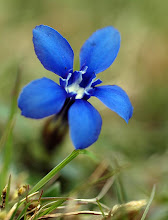This is a cross section of the stem of the plant commonly known as goosegrass or sticky Jack and more scientifically as Galium aparine. Sticky Jack is a very common weed that scrambles up through other vegetation using its covering of hooked hairs on the stem and leaves and which sticks to clothing with these when kids throw handfuls of the stuff at each other.
This image was produced using fluorescence microscopy, staining the cells with compounds that bind to the cell walls and fluoresce. The blue cells have walls made of cellulose and their blue fluorescence is due to the calcofluor that they've been stained with, which fluoresces blue in ultraviolet light. Calcofluor has been used as a 'blue whitener' in washing powders - it binds to the cellulose in cotton fabrics and fluoresces faintly blue in the UV component of sunlight. The yellow staining is due to another fluorescent dye (fluorochrome) called auramine O, which binds to cutin in the outer cuticle of the plant, and to dead, lignified cell walls that give the stem its strength - and it fluoresces yellow. The cuticle in this cross section is the thin yellow line covering the outer surface of the section. The yellow circle in the centre is composed of dead, lignified cells - not particularly well developed in goosegrass because it scrambles over surrounding vegetation rather then investing resources in producing a stout lignified stem of its own.















Amazing, as always.
ReplyDeleteThanks
Thanks for visiting Ron..
ReplyDeleteI have just stumbled upon your blog and am enjoying it completely, Thank you so very much!
ReplyDeleteThanks for visiting Gail, and for your kind comments...
ReplyDelete